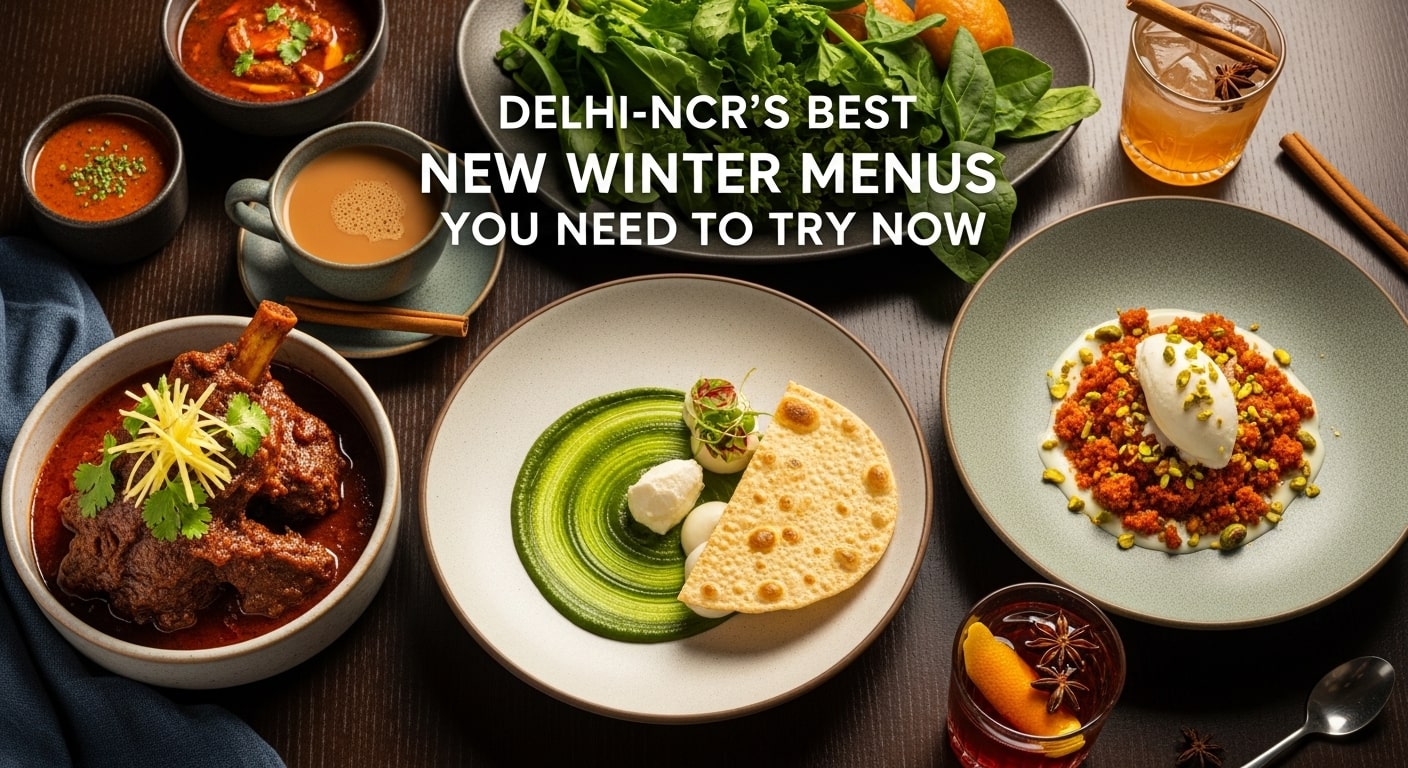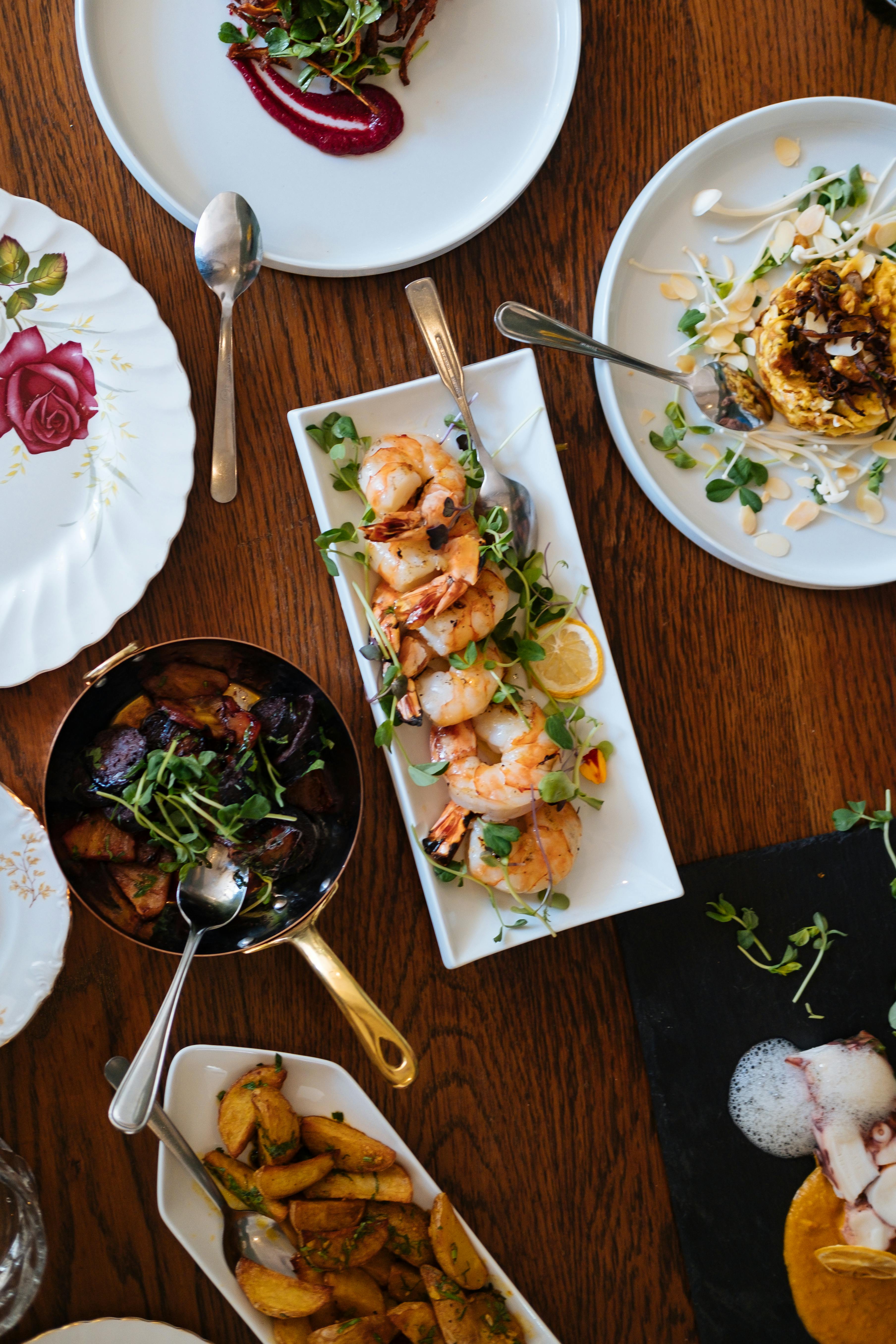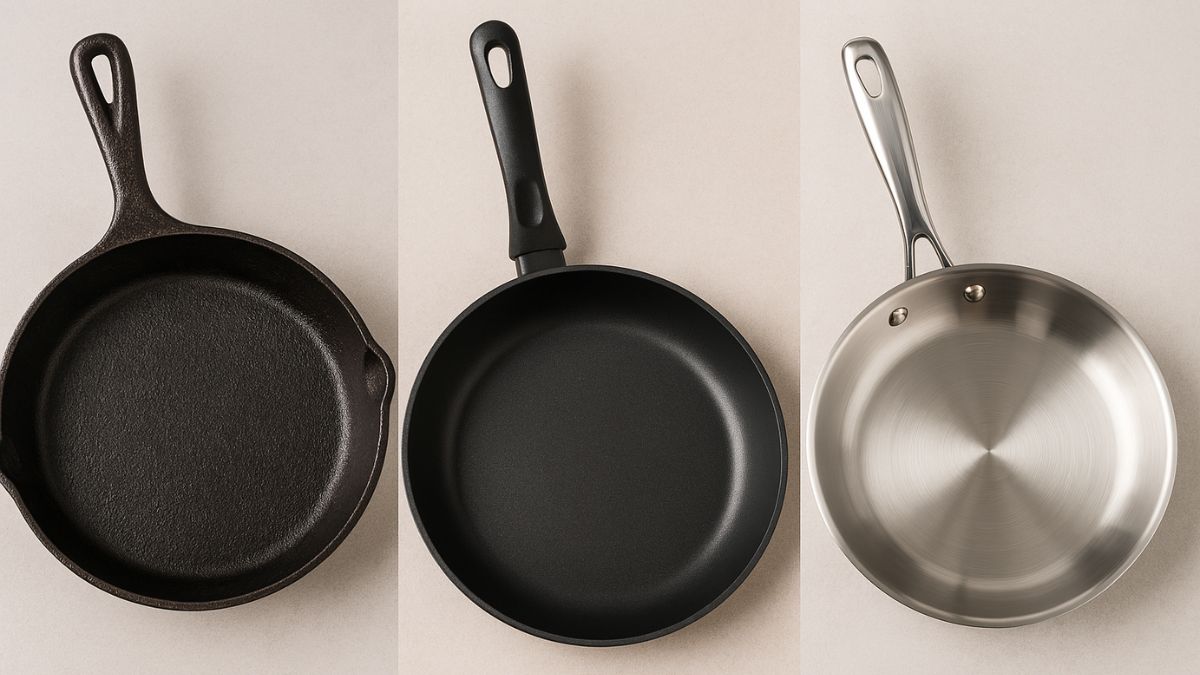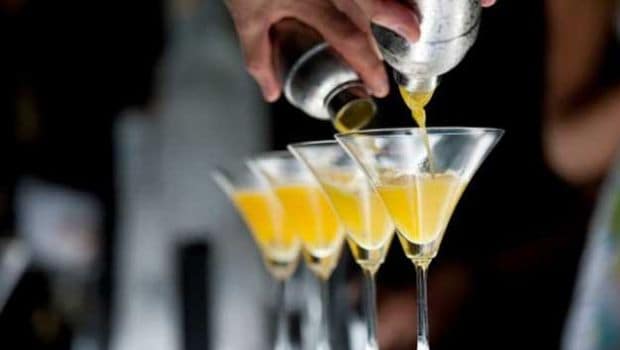I never order dry martinis at bars. If I want a glass of gin, I'll pour it at home and cry into it privately, like you're supposed to. So I rarely see a cocktail that is completely clear and colorless.Which is why the drink I had recently at Caffè Propaganda in Rome intrigued me. I'd ordered from a segment of the cocktail menu featuring spaceships and a futuristic font, and the drink arrived in an elegant coupe, no bubbles or ice shards floating on its surface, faintly pearlescent. The menu had described it only as "unexpected" and "citric."The spirit clearly was rum, and the drink had a silky mouth feel and a deeply tart, sweet flavor. But I couldn't place the citrus. It didn't taste or smell like lemon or lime, yet the drink was so familiar, so close to - a daiquiri?
On our way out, we queried a staffer, who confirmed my suspicion. The drink was rum, rich simple syrup and citric acid. In a message later, bartender Patrick Pistolesi verified: It was "nothing more than a classic daiquiri," stirred and using the clarity of citric acid to trick the guest. It might have been wearing an Armani spacesuit, but there was a guayabera shirt underneath.I liked the startling dissonance between the drink's appearance and its flavor, but I felt a little guilty. It was a daiquiri with no limes in sight: a daiquiri, I thought, that one might drink underground once the human race is forced to retreat there; where parents might pour white powder into their children's hands and tell stories of how this chemically preserved flavor once came from green orbs plucked from mysterious "trees" whose branches danced in "sunlight" near vast "beaches" where "gringos" told lies about the drinking habits of some guy named Hemingway.One of the commandments of the craft cocktail movement - between "Thou Shalt Not Shake a Manhattan" and "Thou Shall Keep Holy (and Refrigerated) Thy Vermouth" - is to avoid commercial sour mix, that manufactured, chemical-laden, neon-green syrup that was everywhere in the crappy drinks of the 1970s and 1980s. Check out the ingredients listed on a bottle sometime: a lot of multisyllabic chemicals, and citric acid will be prominent. The acid used to be made from citrus fruits, but since the 1920s, it has more frequently been made through the fermentation of mold.Drinking a citric acid-based drink at a fancy cocktail joint gave me a nervous feeling, as if Ashton Kutcher might lunge out of the freezer at any moment to announce I'd been punk'd by something made from the same stuff as powdered lemonade.It's easy to make citric acid sound creepy, but remember: Penicillin is made through a similar process. There's a chemistry-geek strain running through some craft cocktail bars, an offshoot of modernist cuisine. Here it was used cleverly and well. But the drink did make me wonder whether we might be getting to "Jurassic Park" cocktails: so excited at what we can do, we don't think about whether we should do it. (Usually I have those thoughts when confronting bloody marys that have five pounds of brunch items protruding from them.)Dave Arnold was clearly the guy to talk to. Arnold's James Beard Award-winning book "Liquid Intelligence: The Art and Science of the Perfect Cocktail" brings an experimental, science-based approach to drink making. His recently shuttered Manhattan bar, Booker and Dax (he's looking for a new location), provided one of the best cocktail evenings I've ever had.A section of his book details various acids that create and alter flavors in drinks, flavors as varied as green apple, champagne and sauerkraut. He includes a citric, malic and succinic acid recipe for "lime acid," which, he writes, "is what it says it is: a stand-in for lime juice." But, he adds, he would never use it in place of fruit.I called him to ask why."Almost always, if you use only acids without any real flavors to back it up, it's going to taste kind of like you faked it," Arnold says. "I like to use acids to adjust flavors that are already there, not to create something from nothing." Citrus fruits add flavor, not just acidity, and "there are all these things you're not getting if all you're doing is putting in the acid. It's a lack of complexity."(I thought about the drink in Rome. Yes, it was missing the aromas of lime that are part of the pleasure of a classic daiquiri. But on the other hand, had I perhaps also noticed the taste of the rum more than I usually do? Did it sacrifice one layer of complexity to highlight another?)Arnold could remember using acids alone once, to create a Campari spritzer in which he wanted a wine flavor and boosted acidity but no citrus flavors. Even then, he points out, it was about adjusting the acidity of the Campari, not creating a flavor that wasn't there.One of the best uses for Arnold's lime acid is with orange juice. OJ isn't tart enough to serve as a souring agent in most cocktails. "But it has all those real citrus flavors and aromas, because it's real," Arnold says. Adjusting the acidity with lime acid creates an orange juice that pops sour while retaining its characteristic fragrance and sunshine.Julien-Pierre Bourgon uses mouth-tingling acid phosphate - once a staple at soda fountains and a onetime ingredient in Coca-Cola - to pep up drinks, including the spiced-pineapple-and-bourbon Whiskey Tonka Foxtrot at Masseria in Washington. He likes its neutral sourness; the specific notes of citrus fruits don't work with every flavor, and he says some acid powders have a candylike note he's not crazy about."In the past, we've done things where you cook down a cinnamon-vanilla syrup, and if you add just a little citric acid, it will taste a bit like cola but still have its viscosity," says Bourgon. "And then you can make kind of a cola old-fashioned, with that richer mouth feel."I've played with that approach, using citric acid with honey and smoked paprika to create a richly tart, smoky bourbon lowball, and with makrut lime leaves, lemon grass stalks and Thai bird chilies for a tart, complex syrup that not only works with the Thai Lime Fizz, but also can be used to make intense short cocktails. Try stirring it with rum and coconut water to make a spice-inflected daiquiri.The bottled ectoplasm of sour mix may be a throwback from the Dark Age of drinks, but adventurous drinkmakers may find value in exploring some of these other sources of sour. Learn, experiment, take what's useful, and leave the rest (I'm looking at you, sodium benzoate) on the light-up disco floor where it belongs.- - -Thai Lime Fizz1 servingThis bright, spicy drink uses powdered acids as a replacement for the lime juice in the base syrup, then accents the sour with the fragrance of makrut lime leaves and lemon grass.You can order the acid powders online; citric acid is widely available at health food stores. Makrut lime leaves are sold at Indian markets. We used Tanqueray Rangpur lime gin, but any citrus-forward gin will do.MAKE AHEAD: You'll have plenty of leftover lime syrup, which can be mixed with tonic water or club soda for a refreshing mocktail. It can be refrigerated for up to 1 month.From Spirits columnist M. Carrie Allan.IngredientsFor the lime syrup
1/2 ounce chopped makrut lime leaves, preferably fresh (see headnote)
1/2 ounce chopped fresh lemon grass (tender white inner stalk only)
1 small Thai bird chili pepper, chopped (including seeds)
2 cups sugar
2 cups water
1/4 teaspoon powdered malic acid (see headnote)
3/4 teaspoon powdered citric acid (see headnote)
For the drink
Ice
1 1/2 ounces citrus-forward gin, such as Tanquerary Rangpur or Tanqueray 10
2 to 3 ounces tonic water
Lime wheel or lemon grass stalk, for garnishStepsFor the syrup: Combine the chopped herbs, chopped pepper, sugar and water in a small saucepan over medium-high heat; bring to a boil, then reduce to medium-low and cook for 15 minutes or until the syrup has taken on some green color and tastes bright and spicy.Turn off the heat. Stir in the powdered malic and citric acids until they dissolve.Use a fine-mesh strainer to strain out and discard any solids, capturing the syrup in a heatproof container. Cover and refrigerate until well chilled.The yield is a scant 2 cups; you'll need 1 ounce for this recipe. The rest can be refrigerated for up to 1 month.For the drink: Fill a Collins or other tall, narrow glass two-thirds full with ice.Add the gin and ounce of lime syrup, stirring to combine.Top with the tonic water (as needed) and stir gently.Garnish with the lime wheel or lemon grass stalk. Serve right away.Nutrition: Per serving: 190 calories, 0 g protein, 24 g carbohydrates, 0 g fat, 0 g saturated fat, 0 mg cholesterol, 10 mg sodium, 0 g dietary fiber, 23 g sugar.- - -Whiskey Tonka Foxtrot1 servingTart acid phosphates were a staple of soda fountains of yore. In this tingly highball, Julien-Pierre Bourgon adds a few dashes to enliven spiced pineapple juice and bourbon.You can order acid phosphate online. Bourgon uses tonka beans in his syrup; if you can't get them, use a vanilla bean and a stick of cinnamon instead.MAKE AHEAD: Leftover pineapple mix can be refrigerated in an airtight container for up to 1 week.Adapted from Julien-Pierre Bourgon, bartender-manager at Masseria in Washington.IngredientsFor the pineapple mix
1 cup pineapple juice, preferably fresh
1/4 cup sugar
Half star anise
One tonka bean (may substitute 1 split vanilla bean plus one 3-inch cinnamon stick)
For the drink
Ice
1 1/2 ounces bourbon
5 dashes acid phosphate (see headnote)
Club soda
Peychaud's bittersStepsFor the pineapple mix: Combine the juice, sugar and spices in a small saucepan over low heat.Cook for 5 minutes, then cool; strain out and discard the solids, capturing the mixture in a heatproof container. The yield is about 1 cup; you'll need 1 1/2 ounces for this recipe.For the drink: Fill a Collins or other tall, narrow glass with ice.Fill a shaker with ice, then add the 1 1/2 ounces of pineapple mix, the bourbon and acid phosphate. Seal and shake vigorously for 15 seconds, then strain into the glass.Top with club soda and garnish with the bitters.Nutrition: Per serving: 170 calories, 0 g protein, 16 g carbohydrates, 0 g fat, 0 g saturated fat, 0 mg cholesterol, 20 mg sodium, 0 g dietary fiber, 15 g sugar(This story has not been edited by NDTV staff and is auto-generated from a syndicated feed.)
On our way out, we queried a staffer, who confirmed my suspicion. The drink was rum, rich simple syrup and citric acid. In a message later, bartender Patrick Pistolesi verified: It was "nothing more than a classic daiquiri," stirred and using the clarity of citric acid to trick the guest. It might have been wearing an Armani spacesuit, but there was a guayabera shirt underneath.I liked the startling dissonance between the drink's appearance and its flavor, but I felt a little guilty. It was a daiquiri with no limes in sight: a daiquiri, I thought, that one might drink underground once the human race is forced to retreat there; where parents might pour white powder into their children's hands and tell stories of how this chemically preserved flavor once came from green orbs plucked from mysterious "trees" whose branches danced in "sunlight" near vast "beaches" where "gringos" told lies about the drinking habits of some guy named Hemingway.One of the commandments of the craft cocktail movement - between "Thou Shalt Not Shake a Manhattan" and "Thou Shall Keep Holy (and Refrigerated) Thy Vermouth" - is to avoid commercial sour mix, that manufactured, chemical-laden, neon-green syrup that was everywhere in the crappy drinks of the 1970s and 1980s. Check out the ingredients listed on a bottle sometime: a lot of multisyllabic chemicals, and citric acid will be prominent. The acid used to be made from citrus fruits, but since the 1920s, it has more frequently been made through the fermentation of mold.Drinking a citric acid-based drink at a fancy cocktail joint gave me a nervous feeling, as if Ashton Kutcher might lunge out of the freezer at any moment to announce I'd been punk'd by something made from the same stuff as powdered lemonade.It's easy to make citric acid sound creepy, but remember: Penicillin is made through a similar process. There's a chemistry-geek strain running through some craft cocktail bars, an offshoot of modernist cuisine. Here it was used cleverly and well. But the drink did make me wonder whether we might be getting to "Jurassic Park" cocktails: so excited at what we can do, we don't think about whether we should do it. (Usually I have those thoughts when confronting bloody marys that have five pounds of brunch items protruding from them.)Dave Arnold was clearly the guy to talk to. Arnold's James Beard Award-winning book "Liquid Intelligence: The Art and Science of the Perfect Cocktail" brings an experimental, science-based approach to drink making. His recently shuttered Manhattan bar, Booker and Dax (he's looking for a new location), provided one of the best cocktail evenings I've ever had.A section of his book details various acids that create and alter flavors in drinks, flavors as varied as green apple, champagne and sauerkraut. He includes a citric, malic and succinic acid recipe for "lime acid," which, he writes, "is what it says it is: a stand-in for lime juice." But, he adds, he would never use it in place of fruit.I called him to ask why."Almost always, if you use only acids without any real flavors to back it up, it's going to taste kind of like you faked it," Arnold says. "I like to use acids to adjust flavors that are already there, not to create something from nothing." Citrus fruits add flavor, not just acidity, and "there are all these things you're not getting if all you're doing is putting in the acid. It's a lack of complexity."(I thought about the drink in Rome. Yes, it was missing the aromas of lime that are part of the pleasure of a classic daiquiri. But on the other hand, had I perhaps also noticed the taste of the rum more than I usually do? Did it sacrifice one layer of complexity to highlight another?)Arnold could remember using acids alone once, to create a Campari spritzer in which he wanted a wine flavor and boosted acidity but no citrus flavors. Even then, he points out, it was about adjusting the acidity of the Campari, not creating a flavor that wasn't there.One of the best uses for Arnold's lime acid is with orange juice. OJ isn't tart enough to serve as a souring agent in most cocktails. "But it has all those real citrus flavors and aromas, because it's real," Arnold says. Adjusting the acidity with lime acid creates an orange juice that pops sour while retaining its characteristic fragrance and sunshine.Julien-Pierre Bourgon uses mouth-tingling acid phosphate - once a staple at soda fountains and a onetime ingredient in Coca-Cola - to pep up drinks, including the spiced-pineapple-and-bourbon Whiskey Tonka Foxtrot at Masseria in Washington. He likes its neutral sourness; the specific notes of citrus fruits don't work with every flavor, and he says some acid powders have a candylike note he's not crazy about."In the past, we've done things where you cook down a cinnamon-vanilla syrup, and if you add just a little citric acid, it will taste a bit like cola but still have its viscosity," says Bourgon. "And then you can make kind of a cola old-fashioned, with that richer mouth feel."I've played with that approach, using citric acid with honey and smoked paprika to create a richly tart, smoky bourbon lowball, and with makrut lime leaves, lemon grass stalks and Thai bird chilies for a tart, complex syrup that not only works with the Thai Lime Fizz, but also can be used to make intense short cocktails. Try stirring it with rum and coconut water to make a spice-inflected daiquiri.The bottled ectoplasm of sour mix may be a throwback from the Dark Age of drinks, but adventurous drinkmakers may find value in exploring some of these other sources of sour. Learn, experiment, take what's useful, and leave the rest (I'm looking at you, sodium benzoate) on the light-up disco floor where it belongs.- - -Thai Lime Fizz1 servingThis bright, spicy drink uses powdered acids as a replacement for the lime juice in the base syrup, then accents the sour with the fragrance of makrut lime leaves and lemon grass.You can order the acid powders online; citric acid is widely available at health food stores. Makrut lime leaves are sold at Indian markets. We used Tanqueray Rangpur lime gin, but any citrus-forward gin will do.MAKE AHEAD: You'll have plenty of leftover lime syrup, which can be mixed with tonic water or club soda for a refreshing mocktail. It can be refrigerated for up to 1 month.From Spirits columnist M. Carrie Allan.IngredientsFor the lime syrup
1/2 ounce chopped makrut lime leaves, preferably fresh (see headnote)
1/2 ounce chopped fresh lemon grass (tender white inner stalk only)
1 small Thai bird chili pepper, chopped (including seeds)
2 cups sugar
2 cups water
1/4 teaspoon powdered malic acid (see headnote)
3/4 teaspoon powdered citric acid (see headnote)
For the drink
Ice
1 1/2 ounces citrus-forward gin, such as Tanquerary Rangpur or Tanqueray 10
2 to 3 ounces tonic water
Lime wheel or lemon grass stalk, for garnishStepsFor the syrup: Combine the chopped herbs, chopped pepper, sugar and water in a small saucepan over medium-high heat; bring to a boil, then reduce to medium-low and cook for 15 minutes or until the syrup has taken on some green color and tastes bright and spicy.Turn off the heat. Stir in the powdered malic and citric acids until they dissolve.Use a fine-mesh strainer to strain out and discard any solids, capturing the syrup in a heatproof container. Cover and refrigerate until well chilled.The yield is a scant 2 cups; you'll need 1 ounce for this recipe. The rest can be refrigerated for up to 1 month.For the drink: Fill a Collins or other tall, narrow glass two-thirds full with ice.Add the gin and ounce of lime syrup, stirring to combine.Top with the tonic water (as needed) and stir gently.Garnish with the lime wheel or lemon grass stalk. Serve right away.Nutrition: Per serving: 190 calories, 0 g protein, 24 g carbohydrates, 0 g fat, 0 g saturated fat, 0 mg cholesterol, 10 mg sodium, 0 g dietary fiber, 23 g sugar.- - -Whiskey Tonka Foxtrot1 servingTart acid phosphates were a staple of soda fountains of yore. In this tingly highball, Julien-Pierre Bourgon adds a few dashes to enliven spiced pineapple juice and bourbon.You can order acid phosphate online. Bourgon uses tonka beans in his syrup; if you can't get them, use a vanilla bean and a stick of cinnamon instead.MAKE AHEAD: Leftover pineapple mix can be refrigerated in an airtight container for up to 1 week.Adapted from Julien-Pierre Bourgon, bartender-manager at Masseria in Washington.IngredientsFor the pineapple mix
1 cup pineapple juice, preferably fresh
1/4 cup sugar
Half star anise
One tonka bean (may substitute 1 split vanilla bean plus one 3-inch cinnamon stick)
For the drink
Ice
1 1/2 ounces bourbon
5 dashes acid phosphate (see headnote)
Club soda
Peychaud's bittersStepsFor the pineapple mix: Combine the juice, sugar and spices in a small saucepan over low heat.Cook for 5 minutes, then cool; strain out and discard the solids, capturing the mixture in a heatproof container. The yield is about 1 cup; you'll need 1 1/2 ounces for this recipe.For the drink: Fill a Collins or other tall, narrow glass with ice.Fill a shaker with ice, then add the 1 1/2 ounces of pineapple mix, the bourbon and acid phosphate. Seal and shake vigorously for 15 seconds, then strain into the glass.Top with club soda and garnish with the bitters.Nutrition: Per serving: 170 calories, 0 g protein, 16 g carbohydrates, 0 g fat, 0 g saturated fat, 0 mg cholesterol, 20 mg sodium, 0 g dietary fiber, 15 g sugar(This story has not been edited by NDTV staff and is auto-generated from a syndicated feed.)
Advertisement












